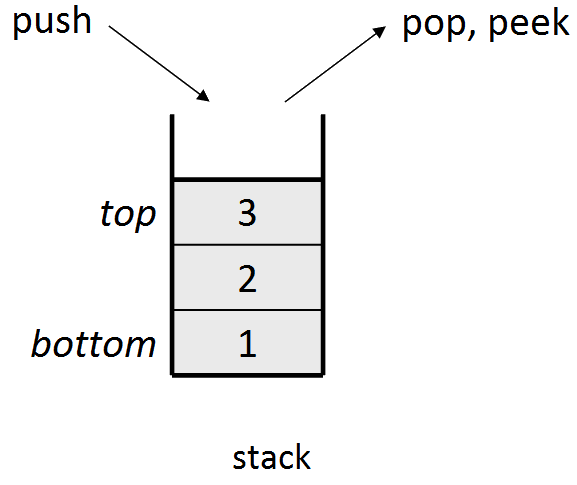Understand:
- what's a Stack
- LIFO
- Stack Methods
- how to implement a stack
A Stack is an abstract data structure we use in storing data.
A stack, like in real life, is a piled structure of items, such as a stack of plates as pictured below. You can only add or take away dishes at the top of the stack (pile).
A more traditional representation looks like:
Because we can only interact with the top of the stack, the last thing we put into the stack is the first thing that will come out. This is called Last In First Out or LIFO.
In our dish stack above, the last dish that we put away will be the first one we pick back up when need to use another dish.
A stack has the following methods:
push() : Adds a new element to the top of the stack
pop() : Removes and returns the top element of the stack
peek() : Returns the top element of the stack without removing it
isEmpty() : Returns whether or not the stack has any elements inside of it
Access an element
O(n)Find an element
O(n)Insert an element
O(1)Delete an element
O(1)- Back button in a browser
- Undo feature in a text editor
- Navigation Stack in a Navigation Controller
We can implement a stack two different ways.
- Using the built-in Array structure
- Using a custom linked list
This illustrates the difference between an abstract data type and a data structure
An abstract data type speaks only to the conceptual behavior and not to the specific implementation.
A data structure is talking about how information is actually stored in memory.
More reading: Stack Overflow
struct Stack<T> {
private var arr: [T] = []
public var peek: T? {
return arr.last
}
public var isEmpty: Bool {
return arr.count == 0
}
mutating func push(_ newElement: T) {
arr.append(newElement)
}
mutating func pop() -> T? {
return arr.popLast()
}
}Node and LinkedList implementations
class Node<T: Comparable>: CustomStringConvertible, Equatable {
public var value: T
public var next: Node?
var description: String {
guard let next = next else { return "\(value) -> nil" }
return "\(value) -> \(next)"
}
static func ==(lhs: Node, rhs: Node) -> Bool {
return
lhs.value == rhs.value &&
lhs.next == rhs.next
}
init(value: T) {
self.value = value
}
}
struct LinkedList<T: Comparable>: CustomStringConvertible {
private var head: Node<T>?
private var tail: Node<T>?
var description: String {
guard let head = head else { return "empty list" }
return "\(head)"
}
public var first: Node<T>? {
return head
}
public var last: Node<T>? {
return tail
}
public var isEmpty: Bool {
return head == nil
}
public mutating func append(_ value: T) {
let newNode = Node(value: value)
if let lastNode = tail {
lastNode.next = newNode
} else {
head = newNode
}
tail = newNode
}
public mutating func removeLast() -> Node<T>? {
guard !isEmpty else { return nil }
var removedNode: Node<T>?
if head == tail {
removedNode = head
head = nil
tail = nil
}
var currentNode = head
while currentNode != nil {
if currentNode?.next == tail {
removedNode = currentNode?.next
currentNode?.next = nil
tail = currentNode
}
currentNode = currentNode?.next
}
return removedNode
}
}struct Stack<T: Comparable>: CustomStringConvertible {
private var items = LinkedList<T>()
public var isEmpty: Bool {
return items.first == nil
}
public var peek: T? {
return items.last?.value
}
public var top: Node<T>? {
return items.last
}
public var bottom: Node<T>? {
return items.first
}
var description: String {
guard !items.isEmpty else { return "empty list" }
var str = "["
var currentNode = items.first
while currentNode != nil {
if let currentNode = currentNode {
str += currentNode.next == nil ? "\(currentNode.value)" : "\(currentNode.value), "
}
currentNode = currentNode?.next
}
return str + "]"
}
public mutating func push(_ value: T) {
items.append(value)
}
public mutating func pop() -> T? {
return items.removeLast()?.value
}
}Whiteboard Exercises
Pair up according to your group to solve the whiteboard exercises

